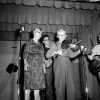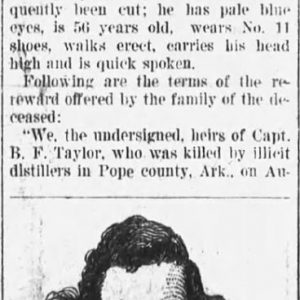calsfoundation@cals.org
William Harvey (Harve) Bruce (1847–1907)
Harve Bruce was a moonshiner who resided on Oak Mountain in Van Buren County. Pursued by local and federal authorities, Bruce shot and killed two U.S. marshals, although his sentences for moonshining were longer than his sentence for killing the marshals.
William Harvey (Harve) Bruce was born on June 23, 1847, to William and Sarah Bruce of Georgia. The family moved to Winston County, Alabama, to earn money through tenant farming. However, the Civil War began soon after, and his father joined the Confederate army. Without any financial support, his mother moved the family closer to relatives in Cherokee County, North Carolina. Two years into the fighting, Harve Bruce joined the Confederate army after turning sixteen. Serving for the remainder of the war, he fought in the infantry division Company D, Thomas’s Legion, led by Colonel William Holland Thomas. This was one of the few regiments in which Cherokee and white soldiers fought alongside each other. The group remained primarily in North Carolina during the Civil War.
Harve Bruce married Hannah Cotter of North Carolina in 1871. The couple soon moved to Arkansas and settled in Archey Valley Township, located in Van Buren County. The couple had their first child in 1872. Harve and Hannah Bruce raised their family in Archey Valley Township until the mid-1890s, when Harve received a homestead land grant for 160 acres in Wheeler (Van Buren County). The soil was poor on Oak Mountain, so Bruce focused upon transforming his corn into moonshine to gain extra money. Despite this illegal activity, Bruce stayed close to authorities by serving as a sheriff’s deputy for Van Buren County. Bruce created connections through moonshining as well. His neighbor, Turner Skidmore, made moonshine and partnered with Bruce in 1896.
With growing tensions between authorities and moonshiners, a search party set out for Bruce’s home in 1897. Tom Barnes, a decade–long friend of Bruce, agreed to show authorities Bruce’s location in exchange for a ten-dollar reward. When authorities arrived, they found only Hannah and the Bruce children at the home. Hannah agreed to send her daughter to find Bruce, but upon hearing his daughter’s message, Bruce and Skidmore hid in the woods. Angered over the deceit, authorities threatened to arrest Bruce’s daughter, who had returned without him. To avoid this escalation, Bruce’s brother went to meet with Bruce in the woods without the officers. Angry with how the officers were handling the situation, Bruce agreed to meet privately with one of the officers. A long standoff ensued, ultimately concluding without gunshots. The authorities retreated in defeat. Overnight, Bruce and Skidmore dismantled their distilling site and moved to join their other moonshine partners, Alva Church and Dave Milsap. The following morning, deputies returned to the Bruce homestead and burned the remaining foundation of the distilling site.
Local authorities regrouped and recruited two U.S. marshals, Benjamin F. Taylor and Joe Dodson. Tipped off again by Tom Barnes to Bruce and Skidmore’s location, the posse hid near Milsap’s home, recording the outlaws’ daily routine. On the morning of August 29, 1897, the group slowly crept up the hill toward Bruce and Church.
The following events were reported differently by the two groups. According to Bruce, the marshals began firing upon the men without giving a warning or identifying themselves. Church ran, escaping the gunfire, but Bruce decided to fire back. Bruce shot Dodson in the head and soon after hit Taylor. However, local papers originally reported that the marshals were “suddenly fired upon from ambush and instantly killed.” Regardless which report is true, Bruce escaped with a minor leg injury, having killed two marshals and injured two local authorities.
Bruce fled and settled in Alabama. The U.S. Marshals Office established a $450 reward for the outlaw, along with additional private rewards by the victims’ families. The reward led to Bruce’s neighbor, J. W. Gist, capturing the moonshiner on one of Bruce’s secret periodic visits to his home in October 1898. Shortly after his capture, Bruce was tried on a charge of illicit distilling, receiving a three–year prison sentence at Fort Leavenworth Penitentiary in Kansas, where his partners were already serving their sentences. However, this became a problem when the Pope County court system wanted to transfer custody of Bruce to their court so that he might be charged for the deaths of the two marshals. Due to the illicit distilling offense being classified as a federal crime, the moonshiners had to serve their sentences before they could be transferred for the other trial. This prompted President William McKinley to grant Bruce, Milsap, Skidmore, and Church a presidential pardon, ending their sentences early.
Bruce’s trial for the deaths began in the fall of 1899. One hundred and fifty witnesses were evaluated by the defense and the prosecution throughout the trial. To the shock of many, the trial concluded with a jury finding Bruce guilty of manslaughter rather than murder. Additionally, the court set Bruce’s sentence at six months, and Bruce’s defense attorneys, unhappy with the surprisingly light sentence, appealed to the Arkansas Supreme Court. As the appeal processed, Bruce posted bond and returned home. His freedom ended abruptly in December 1899 when he was arrested by Deputy Marshal J. G. Botsford for illicit distilling.
The Arkansas Supreme Court ultimately declined Bruce’s appeal and upheld the court’s ruling, stating that they “were unreasonably lenient to him and he has no right to complain.” Bruce surrendered to authorities and served his sentence at the newly built state penitentiary in Little Rock (Pulaski County). Bruce’s sentence was marked by good behavior. He was eventually appointed to armed guard duty by the warden, who was impressed by the criminal’s rifle skills. Ultimately, Bruce served only four months before being pardoned by newly elected Governor Jeff Davis. Bruce’s trial for his new charge of illicit distilling resulted in the moonshiner receiving a three-year sentence to be carried out at Fort Leavenworth Penitentiary. For the first time in his life, Bruce served his full sentence for the charge and returned home to Oak Mountain in November 1903. Bruce died on March 26, 1907.
For additional information:
“All over Arkansas.” Arkansas Gazette, November 12, 1903, p. 4.
“Bruce Captured.” Arkansas Gazette, October 5, 1898, p. 3.
“Bruce Doing Guard Duty.” Southern Standard, August 16, 1900, p. 1.
“Bruce Is Sentenced.” Arkansas Democrat, October 5, 1898, p. 1.
“Bruce v. State.” South Western Reporter 57 (1900): 1105.
“Church Acquitted.” Arkansas Gazette, November 17, 1899, p. 2.
“Deputies Murdered.” Osceola Times, September 4, 1897, p. 6.
“Harve Bruce; Gray Haired Mountaineer Sentenced to 3 Years for Illicit Distilling.” Arkansas Democrat, April 24, 1901, p. 8.
“Harve Bruce Again.” Arkansas Democrat, December 18, 1899, p. 5.
Moneyhon, Carl H. Arkansas and the New South: 1874–1929. Fayetteville: University of Arkansas Press, 1997.
“Pardoned by President.” Green Bay Press-Gazette, May 27, 1899, p. 1.
Perkins, J. Blake. Hillbilly Hellraisers: Federal Power and Populist Defiance in the Ozarks. Urbana: University of Illinois Press, 2017.
“Reward for Bruce and Skidmore.” Southern Standard, October 8, 1897, p. 4.
Patricia Bruno
Arkansas Tech University
 Folklore and Folklife
Folklore and Folklife Law
Law Post-Reconstruction through the Gilded Age, 1875 through 1900
Post-Reconstruction through the Gilded Age, 1875 through 1900 Harve Bruce Conviction Article
Harve Bruce Conviction Article 



Comments
No comments on this entry yet.